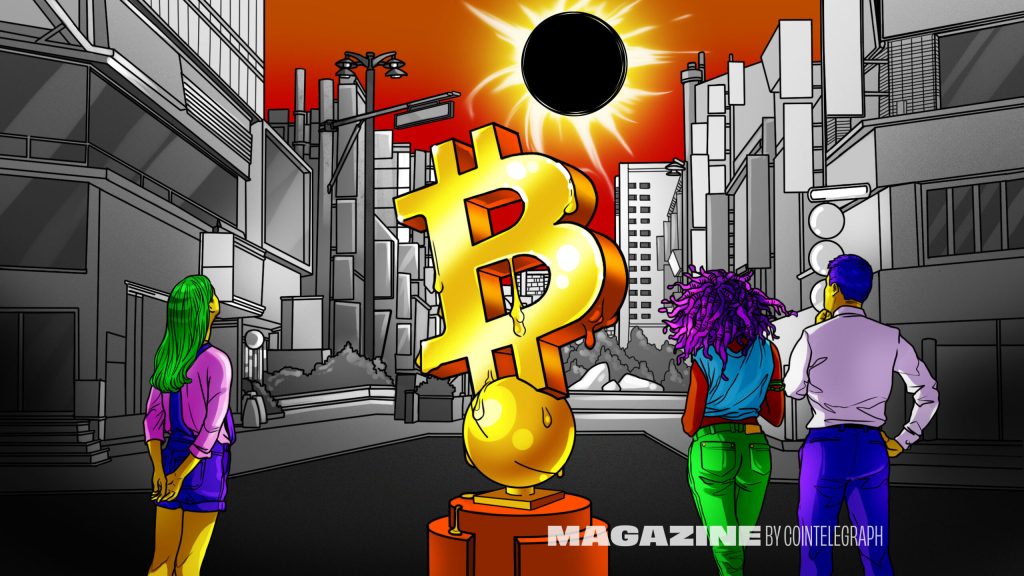Can Bitcoin survive a Carrington Event knocking out the grid? – Cointelegraph Magazine

[ad_1]
“In a massive solar storm, which would be hugely damaging to a modern economy’s infrastructure, the blockchain parts might well be the only parts that survive.” — Jason Potts
What was the Carrington Event?
In a November 1859 meeting of the Royal Astronomical Society, British astronomer Richard Christopher Carrington reported to the esteemed scientific body that “in the forenoon of Thursday, Sept. 1, in taking my customary observation of the forms and positions of the solar spots, an appearance was witnessed which I believe to be exceedingly rare.”
The phenomenon caused brilliant auroras across the globe, some as far south as Cuba, that were so bright observers were able to read newspapers by their light at night.

It was the most intense geomagnetic storm in recorded history, likely the result of a coronal mass ejection from the sun colliding with the Earth’s magnetosphere — and one with worrying implications for the cryptocurrency industry were it to happen again today. A storm of such intensity would have the potential to affect the majority of electrical systems in use today: satellites, internet service providers, power supplies and all forms of communication.
The geomagnetic disturbances were so strong that telegraph operators in the United States reported sparks leaping from their equipment, which in some cases even caught fire. Telegraph systems across Europe and North America failed.

Similar events were seen throughout the 20th century. In 1921, a solar storm was broadly observed in and around New York City in the United States. The electrical disturbances knocked out the signal and switching operations of the commuter rail system, blowing fuses and setting the signal tower of Grand Central Terminal on fire. Telegraph wires crackled as communications ground to a halt.
And in 1989, a storm knocked out power across large sections of Quebec in Canada. Scientists believe that an event even more massive than the Carrington one occurred in 774, called the Miyake Event.
As Mississippi State University professor David Wallace wrote on Astronomy.com, the potential ramifications could be disastrous:
“It is only a matter of time before Earth is hit by another geomagnetic storm. A Carrington Event-size storm would be extremely damaging to the electrical and communication systems worldwide with outages lasting into the weeks. If the storm is the size of the Miyake Event, the results would be catastrophic for the world with potential outages lasting months if not longer.”
What would happen to Bitcoin after a solar flare?
From in-home personal computers to the internet and the birth of cryptocurrencies, an economic and technological revolution occurred around the turn of the 21st century, one that relies entirely on an interconnected web of global communications systems.
Within these systems, traditional payments providers like credit card companies, banks or remittance firms form “payments stacks” — blocks of trusted, interconnected entities that process and settle electronic payment transactions.
Amazon Web Services experts have reported that most of this is still stored on aging banking systems first built in the early second half of the 20th century. While some banks have attempted to upgrade, “the vast majority stuck with the tried-and-true mainframe, which they rely on to this day.”

In contrast, Satoshi Nakamoto aimed to create a payments system that is decentralized and distributed across a network of computers, or nodes, rather than relying on a verticalized system stored in a single-entity server or data center. There is no single point of failure when it comes to the Bitcoin network’s ledger — a trait that leads many to characterize the network as more robust and flexible than other payment systems.
So, which would fare better in a Carrington Event? Or would both fail to survive?
Sunspots and “the golden question”
The traditional payments system has certain redundancies and safeguards built in to ensure that the networks, and their nodes, are protected from extraneous events such as hackers, weather, power outages, power surges and other force majeure.
But a Carrington Event-level solar storm presents an extreme scenario on a much vaster scale, the effects of which experts can still only estimate despite years of constant study.
“We’re monitoring the sun continuously,” William Murtagh, program coordinator at the U.S. National Oceanic and Atmospheric Administration’s Space Weather Prediction Center, tells Magazine. Another event will happen — it’s only a matter of when and how intense it will be.
Read also
Features
Sell or hodl? How to prepare for the end of the bull run, Part 2
Features
Crypto as a ‘public good’ in the 22nd century
When it comes to solar magnetic events, scientists at SWPC look for large sunspots, some larger than the earth, which tend to form at the end of the 11-year solar cycle when the sun’s dipole magnetic fields (think the North and South poles) flip entirely.
Sunspots emerge “all the time,” Murtagh notes, but are mainly observed when the sun is close to its “solar maximum” — the apex of the 11-year-long solar activity cycle. The next such maximum is slated to occur sometime between 2024 and 2025.
“We’re watching it closely, and all of a sudden, the eruption occurs,” Murtagh states. “When this eruption occurs, then we get a variety of emissions. We get the electromagnetic emissions, speed-of-light loads.”
“We’re feeling it here on Earth, and it’s affecting some technologies a couple of hours later — energetic particles flowing in from this eruption. So, now we’re talking about subatomic particles. We’re getting protons and electrons come flowing in, and that will impact other different types of equipment, like satellites, like our astronauts in space, like airplanes flying over the polar region. All can be affected by these energy particles.”
Trailing these light-speed projections from the sun are a billion tons of plasma gas and magnetic fields erupting from the flare source, otherwise known as a coronal mass ejection, or CME. The sun essentially shoots a magnet into space.
“The CME comes to earth as a magnetic host with magnetic fields, so now I’ve got two magnets,” he says. “When they couple in just the right way, […] intense currents will form and manifest themselves right here on earth, flow to the ground — depending on the conductivity of the soil beneath us — and then can damage equipment like the electric power grid.”
“So, if we do get a Carrington-class event, how big of a radiation storm could we get? That’s really the golden question here, right?”
Scientists have looked at a variety of indicators to try to glean what effects such an event could have, everything from ice samples to tree rings, and have identified some events that help them understand “how big, big is.”
NOAA is currently engaged in the space weather benchmarks initiative started by the White House to get a better sense of the consequences of these space weather events.

Could a solar flare wipe out Bitcoin?
We do know there would be significant ramifications for our tech-reliant economy and communications systems. Anything dependent on the united electricity grid and global internet would be especially vulnerable.
So, how would cryptocurrency fare? Jason Potts, a professor at the Royal Melbourne Institute of Technology and the co-director of its Blockchain Innovation Hub, tells Magazine that a Carrington Event-level solar storm would certainly affect anything that relies on electronic infrastructure for its administrative capacities, including mainstream finance and crypto.
“But the difference is that the crypto or blockchain economic infrastructure is distributed,” he says, adding:
“This is the same reason that the internet is robust. It was designed as a networked communication system in the 1960s to be able to withstand a nuclear attack that took out many communication relays. But provided there was enough redundancy in the network pathways, a message could get through.”
According to Potts, the thousands of distributed Bitcoin nodes give the network a much better chance of surviving a catastrophic event, as “an attack will almost certainly fail unless it can take out all of them. If just one survives, that whole system can be reconstituted from that seed.”

What happens to Bitcoin if the internet goes down?
There are projects that provide a connection to the Bitcoin blockchain without the requirement of internet access, providing yet another level of redundancy.
Fernando Nikolić, director of marketing and communications at Blockstream, tells Cointelegraph that Blockstream’s mission is to broadcast the Bitcoin network around the world via satellite, “24/7, 365.”
“It protects users against network interruptions. We started recording certain regions of the world that, for whatever reason, don’t have a reliable internet connection, whether it be because they’re very rural areas where the infrastructure is not very well or they’re in a location where the government or some kind of entity controls the internet in a more authoritative way than perhaps what we are used to in the West,” he says.
Subscribe
The most engaging reads in blockchain. Delivered once a
week.

Blockstream employs five satellites that it updates continuously to transmit the Bitcoin blockchain to users. Downloading the blockchain from one of the satellites is no more difficult than setting up a satellite TV box.
Nikolić says, “Just get a regular dish that you usually use for catching TV channels, and you just need to be able to point it toward whatever satellite is best, and you can just connect there with a very cheap laptop.”
Once a user downloads the blockchain, they can start verifying their own transactions on the laptop connected to the satellite. “If for whatever reason the internet is shut down or is just not connecting, well, the satellite is really a good backup,” Nikolić adds.
Potts notes that true decentralization of a blockchain network is important, as having nodes spread through the four hemispheres of the earth would ensure “security and safety through redundancy,” concluding:
“Maybe some on Mars would be good too. Blockchains are not fast or efficient, but they are robust. In a massive solar storm, which would be hugely damaging to a modern economy’s infrastructure, the blockchain parts might well be the only parts that survive enough to be reconstituted.”
The big question: Will you really need Bitcoin if the world is burning?
Bitcoin’s decentralized, modular nature gives it the best opportunity to relocate and improvise based on available connectivity after a significant geomagnetic event.
However, if a Carrington-level event renders every telephone and computer in an entire hemisphere inoperable and knocks out the power grids, society could be thrown back to preindustrial times.
The big question then becomes: Even if the Bitcoin ledger survives, who will have time to use it when we are scrambling to rebuild society?
Read also
Features
State of Play: India’s Cryptocurrency Industry Prepares For A Billion Users
Features
How to stop your crypto community from imploding
[ad_2]
Source link










